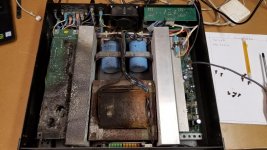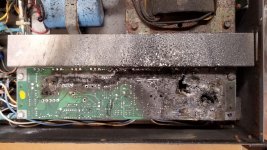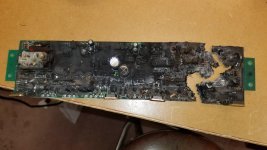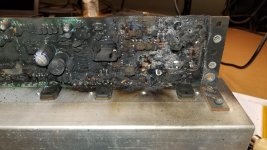Recently I purchased an Ashly FTX-1000 off eBay auction. Upon arrival, it became clear that this amplifier had suffered a catastrophic failure. See attached photos for more information. The seller was excellent, refunded the cost immediately and apologized. He did not want the amplifier back.
I do not have schematics for this amplifier. If anyone does, I would be interested to see them. The module that failed had 4 2SK1058s, all of which are shorted. This leads to question #1:
1) Did Ashly use a Quasi-complimentary output stage with lateral MOSFETs? That seems like a very odd decision given the fact that an excellent compliment (the 2SJ162) exists. If they did not, then it is possible that the failure was caused by a previous service. I can't tell if it has been serviced, however, since any evidence has been burned away with fire.
More information will be posted as I get further into this. I will likely try to clean the destroyed board in some way so I can (hopefully) get a better idea of what parts are charred and what parts aren't.
Unless I can source an FTX-1000 output module before I have a chance to cannibalize this amp for parts, I have no intentions of fixing it. I do not currently know if the main power transformer has suffered any damage, or if it's just dirty.
Interestingly, the sil-pads are still intact! This should answer any questions about whether sil-pads are biodegradable since everything else in the area has pretty much rotted away. I suspect that this amplifier has been sitting for quite a few years since it has almost no smell.
Edit: No, COVID-19 is not the reason it doesn't smell, as I can still smell the dog from from about five feet away.
I do not have schematics for this amplifier. If anyone does, I would be interested to see them. The module that failed had 4 2SK1058s, all of which are shorted. This leads to question #1:
1) Did Ashly use a Quasi-complimentary output stage with lateral MOSFETs? That seems like a very odd decision given the fact that an excellent compliment (the 2SJ162) exists. If they did not, then it is possible that the failure was caused by a previous service. I can't tell if it has been serviced, however, since any evidence has been burned away with fire.
More information will be posted as I get further into this. I will likely try to clean the destroyed board in some way so I can (hopefully) get a better idea of what parts are charred and what parts aren't.
Unless I can source an FTX-1000 output module before I have a chance to cannibalize this amp for parts, I have no intentions of fixing it. I do not currently know if the main power transformer has suffered any damage, or if it's just dirty.
Interestingly, the sil-pads are still intact! This should answer any questions about whether sil-pads are biodegradable since everything else in the area has pretty much rotted away. I suspect that this amplifier has been sitting for quite a few years since it has almost no smell.
Edit: No, COVID-19 is not the reason it doesn't smell, as I can still smell the dog from from about five feet away.
Attachments
Ouch. That is some serious flashover. My guess would be liquid was spilled into the unit while powered on.
I imagine the transformer will be fine and that's largely just spatter from the inferno. It certainly looks like it sourced plenty of juice to reduce that PCB to ash! I'd start by measuring the primary winding for continuity - it's possible there's a thermal fuse and it's opened, but looking at that carnage I doubt it.
The intact channel should be identical apart from the PCB being mirror image. Its possible they used a quasi output stage for some reason such as matching mosfets.
There is no way the seller didnt know that was faulty though. I imagine the smell of charred fibreglass and carbon is immense! Oh well, at least he refunded, and you've at least got a usable chassis if you decide to build your own amplifier.
I imagine the transformer will be fine and that's largely just spatter from the inferno. It certainly looks like it sourced plenty of juice to reduce that PCB to ash! I'd start by measuring the primary winding for continuity - it's possible there's a thermal fuse and it's opened, but looking at that carnage I doubt it.
The intact channel should be identical apart from the PCB being mirror image. Its possible they used a quasi output stage for some reason such as matching mosfets.
There is no way the seller didnt know that was faulty though. I imagine the smell of charred fibreglass and carbon is immense! Oh well, at least he refunded, and you've at least got a usable chassis if you decide to build your own amplifier.
Ouch. That is some serious flashover. My guess would be liquid was spilled into the unit while powered on.
I imagine the transformer will be fine and that's largely just spatter from the inferno. It certainly looks like it sourced plenty of juice to reduce that PCB to ash! I'd start by measuring the primary winding for continuity - it's possible there's a thermal fuse and it's opened, but looking at that carnage I doubt it.
The intact channel should be identical apart from the PCB being mirror image. Its possible they used a quasi output stage for some reason such as matching mosfets.
There is no way the seller didnt know that was faulty though. I imagine the smell of charred fibreglass and carbon is immense! Oh well, at least he refunded, and you've at least got a usable chassis if you decide to build your own amplifier.
I genuinely believe the seller had no idea. I didn't suspect anything until I popped the lid just as a precaution. You couldn't tell from the outside, and there probably weren't parts rattling around inside until UPS bashed it around in their truck for a while. I initially just assumed that what was rattling around inside was just a screw that had backed out. Turns out it was one of the driver transistors😱
The amp hardly has any smell at all. I suspect that this got blown up and sat in storage for upwards of 10 years before it got sold.
There is no way this is liquid damage. Liquid damage doesn't usually cause a large trace to vaporize.
My guess, and this is just a guess based on the level of destruction, is that someone managed to connect the output (or the input) of this amplifier up to a an AC wall receptacle. Some people are eternal cheapskates and try to use extension cords as speaker cables or even (!) line-level cables.
I've never heard of a lateral MOSFET amplifier blowing up in this way. This is the kind of thing that normally would be seen in a Phase Linear 700 or a 1980s Crest amp.
I have trouble believing that there were no signs of damage outside the case! Try communicating with Jim at the service department at Ashly audio.
I recovered one of their amplifiers after a fire that pretty much burned the building completely. All that was left of the amplifier was the steel case and the transformer core inside. So I sent it back for service with a tag that the amplifier had overheated. They decided it was out of warranty!
I recovered one of their amplifiers after a fire that pretty much burned the building completely. All that was left of the amplifier was the steel case and the transformer core inside. So I sent it back for service with a tag that the amplifier had overheated. They decided it was out of warranty!
I am amazed the fuses didnt blow.
I have never seen a pcb burned that bad before.
Quite true.. lends credence to the theory that some idiot shoved mains down the speaker terminals!
Quite true.. lends credence to the theory that some idiot shoved mains down the speaker terminals!
I'm not even sure this amplifier has enough power to do this much damage to itself... I doubt it could vaporize a big trace like that.
I am amazed the fuses didnt blow.
I have never seen a pcb burned that bad before.
I've never seen this level of destruction in an amplifier. A good portion of the PCB crumbles when touched. This is the kind of thing I'm used to seeing in large power supplies, usually accompanied by about 25 or 30 shorted transistors and a large can cap that spewed its guts all over everything.
The mess in here was a close second to said power supply. This amplifier obviously didn't get found right away, and took some time to die its gruesome death.
I tore it down today, and I spent about two hours scrubbing fossilized transistor remains and charred PCB off of the heatsinks. Let me just say that a little heat and moisture reactivated the stench.
The good news is that the transformer tested good. Chassis isn't too bad either, although these aren't the most attractive amps ever made.
Its a PCB fire, not a flashover. PCB isn't supposed to burn, the FR in FR4 means flame-redardent. Something quite big got red hot for some time to start this fire I reckon - FR4 will eventually give in and burn with enough provocation, but not easily - perhaps this wasn't FR4? Looks like some sort of fibreglass from the charring though.Ouch. That is some serious flashover.
The locus of the fire is perhaps the RH driver transistor?
Its a PCB fire, not a flashover. PCB isn't supposed to burn, the FR in FR4 means flame-redardent. Something quite big got red hot for some time to start this fire I reckon - FR4 will eventually give in and burn with enough provocation, but not easily - perhaps this wasn't FR4? Looks like some sort of fibreglass from the charring though.
The locus of the fire is perhaps the RH driver transistor?
Maybe, but the large copper trace that was the audio output has been vaporized.
It's definitely fiberglass. I was surprised to see it this burned as well.
I suppose if mains did get in that's enough voltage to arc/flash. I guess charring then drives off the flame redarddent chemicals and burning ensues.
Come to think of it, being an early 1990s amplifier, is there a chance that the board is made of G-10 instead of FR4?
Does Febreze get rid of the smell of burnt PCB’s, transformers, or voice coils?
Does the remaining channel work? It may have even been left in service with a dead channel, then eventually boxed up and put away when replaced with a modern lightweight.
Does the remaining channel work? It may have even been left in service with a dead channel, then eventually boxed up and put away when replaced with a modern lightweight.
Does Febreze get rid of the smell of burnt PCB’s, transformers, or voice coils?
Does the remaining channel work? It may have even been left in service with a dead channel, then eventually boxed up and put away when replaced with a modern lightweight.
Come to think of it- I'm fairly certain that's the case. I had noticed that there was a little white plug stuffed into one of the pins of the XLR input on the dead channel. At the time I assumed it was just crud that had gotten stuck in there, but I'm fairly certain someone did that to make sure that nobody could plug something into the dead channel.
Regardless, I decided that the chances of finding another module were close to nil, so I've pretty much scrapped the amp. I did keep the remaining good board, and I'll be using the chassis, heatsinks and transformer for a new amp build. If another module magically turns up on eBay tomorrow, well, then I'll rebuild it, but I'd be very surprised if that happened.
- Home
- Amplifiers
- Solid State
- Ashly FTX-1000 Failure Analysis




